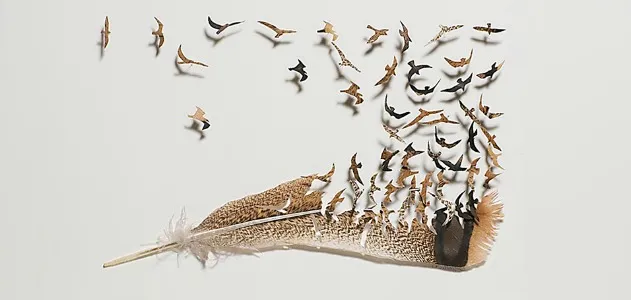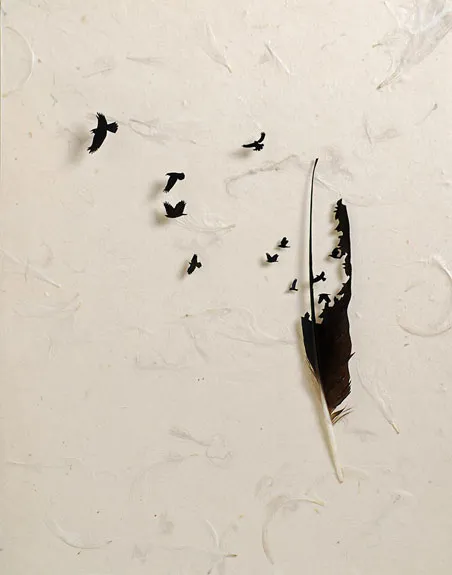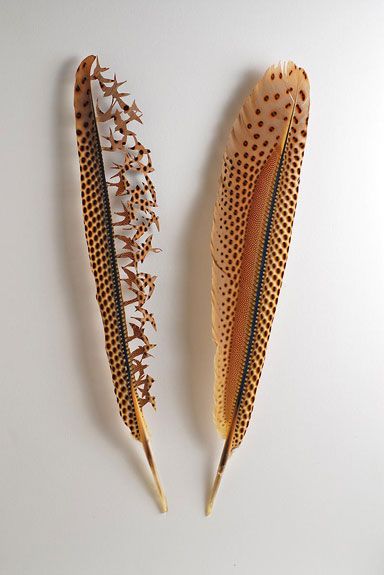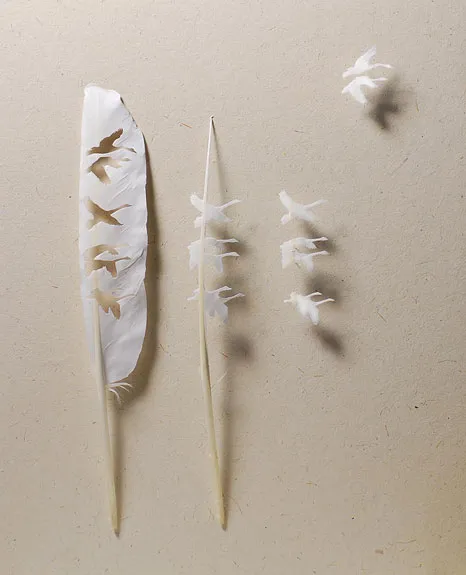Beautiful Artwork Cut Out of Feathers
A clever artist uses a scalpel and tweezers to cut beautiful bird silhouettes out of feathers
/https://tf-cmsv2-smithsonianmag-media.s3.amazonaws.com/filer/Feather-art-631.jpg)
Chris Maynard is obsessed with feathers. The artist, based in Olympia, Wash., thinks feathers show “life’s perfection,” in the way that they overlap and contour to a bird’s body. “Their complexity as a covering beats any clothing we make,” he writes on his Web site.

Going back a few years, Maynard started by photographing feathers. Then, he arranged them in shadow boxes. But, in his experiments in showcasing feathers, Maynard eventually came up with his own unique art form. The artist creates fascinating, feather-light sculptures, by cutting the silhouettes of various types of birds from actual plumage.

Maynard collects molted feathers from generous zoos, private aviaries and nonprofit bird rescue organizations. “Sometimes finding the right feather is the hard part,” he says. The artist may go into a design with a particular color or size of feather in mind. He uses pheasant and parrot feathers mostly, and, from them, he has cut out a whole slew of birds—hummingbirds, woodpeckers, cranes, swans, cockatoos, macaws, peacocks, turkeys, grouse, bitterns, crows and pigeons. Maynard sketches possible designs in notebooks, but to really nail one, he says, “I need to have a feeling about the bird I am portraying.” Maynard, an active member of his local Audubon group and supporter of a land trust that buys property for conservation, balances work in his studio with quality time in the outdoors. “I go out and observe a woodpecker whacking away at a snag or watch crows relating to each other,” he says.

Next comes the cutting. ”When I work, I put on big nerdy magnifying glasses to see the feathers’ details,” Maynard says on his Web site. He also uses fine eye surgery tools he inherited from his father, an ophthalmologist. The scalpels and forceps are not completely foreign to Maynard, whose academic background is in entomology–the study of insects.

The artist is certainly clever in the execution of his designs. Maynard will sometimes use the shaft of the feather as a branch or a tree trunk, perching one or more birds on it. When he wants to portray a singing bird, he takes fluffy down and makes a speech bubble coming out of its open beak. As shown in a couple of photographs here, the artist has also made some of his feathers appear as if flocks of birds are flying out of them. Maynard is a perfectionist (“I am pretty mathematical about it,” he says. “I want each piece to be in the right place.”), and it shows. In total, he has created more than 80 extremely detailed works of feather art.
“I hope that seeing birds in a different light through my artwork will encourage appreciation of avian life and hence a desire to conserve it,” says Maynard.

Maynard’s exhibition “Feather’s Second Flight,” including 25 of his works, is on display through January 20 at the Row House Cafe in Seattle. From January 25 to February 15, his feather art will be shown at the Washington Center for the Performing Arts in Olympia. Maynard and Thor Hanson, a conservation biologist and author of the new book Feathers, will be giving a lecture at the center on February 2.

/https://tf-cmsv2-smithsonianmag-media.s3.amazonaws.com/accounts/headshot/megan.png)
/https://tf-cmsv2-smithsonianmag-media.s3.amazonaws.com/accounts/headshot/megan.png)